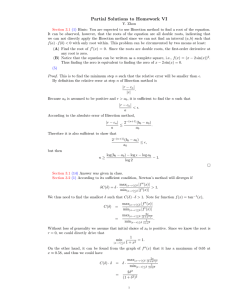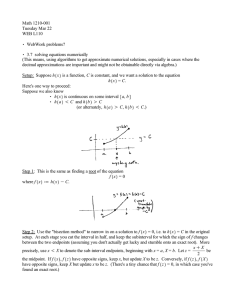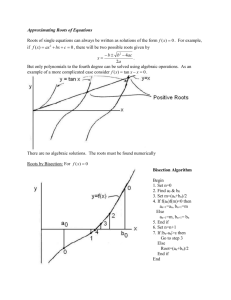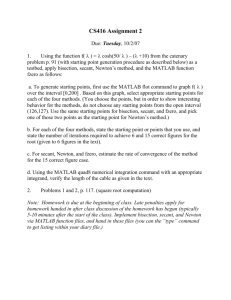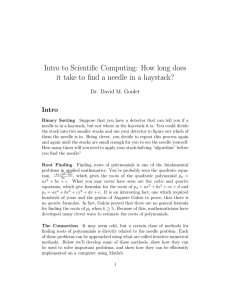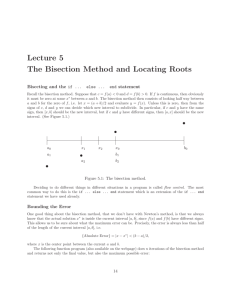Intro to Scientific Computing: Solutions Dr. David M. Goulet
advertisement
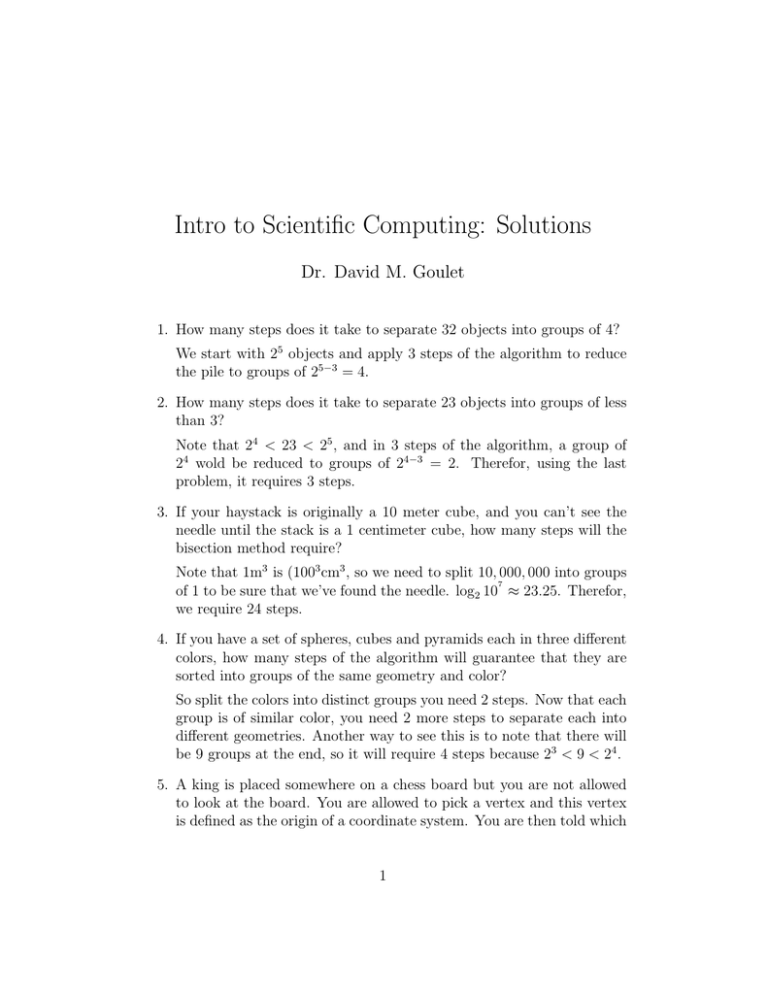
Intro to Scientific Computing: Solutions
Dr. David M. Goulet
1. How many steps does it take to separate 32 objects into groups of 4?
We start with 25 objects and apply 3 steps of the algorithm to reduce
the pile to groups of 25−3 = 4.
2. How many steps does it take to separate 23 objects into groups of less
than 3?
Note that 24 < 23 < 25 , and in 3 steps of the algorithm, a group of
24 wold be reduced to groups of 24−3 = 2. Therefor, using the last
problem, it requires 3 steps.
3. If your haystack is originally a 10 meter cube, and you can’t see the
needle until the stack is a 1 centimeter cube, how many steps will the
bisection method require?
Note that 1m3 is (1003 cm3 , so we need to split 10, 000, 000 into groups
7
of 1 to be sure that we’ve found the needle. log2 10 ≈ 23.25. Therefor,
we require 24 steps.
4. If you have a set of spheres, cubes and pyramids each in three different
colors, how many steps of the algorithm will guarantee that they are
sorted into groups of the same geometry and color?
So split the colors into distinct groups you need 2 steps. Now that each
group is of similar color, you need 2 more steps to separate each into
different geometries. Another way to see this is to note that there will
be 9 groups at the end, so it will require 4 steps because 23 < 9 < 24 .
5. A king is placed somewhere on a chess board but you are not allowed
to look at the board. You are allowed to pick a vertex and this vertex
is defined as the origin of a coordinate system. You are then told which
1
quadrant the king lies in. How many iterations of this “quadsection”
method will guarantee that you find the king.
There are 64 total squares. We are essentially being asked to split these
into groups of 1. So it requires log4 64 = 3 steps.
1. Use the theorem to show that f (x) = x2 − 1 has a root somewhere in
the interval [0, 3].
f (0) = −1 and f (3) = 8
2. Use the theorem to show that f (x) = ex − (x + 2) cos(x) has a root
somewhere in the interval [0, π/2].
f (0) = −2 and f (π/2) = eπ/2 > 0.
3. If a runner finishes a 10 mile race in 60 minutes, was there a 1 mile
section that the runner ran in exactly 6 minutes?
Let the runner’s distance traveled by time t be given by f (t). Now,
define g(t) = f (t) − f (t − 6). Note that g(0) = 0. Suppose that
g(t) < 1 for all t. Then
10 = f (60) − f (0)
= f (60) − f (54) + f (54) − f (48) + . . . + f (6) − f (0)
= g(60) + g(54) + . . . + g(6) < 10
This is a contradiction. So there is at least one value of t ∈ [0, 60] so
that g(t) ≥ 1. Because g(0) = 0, the intermediate value theorem tells
us that there is at least one value of t so that g(t) = 1.
1. If f (0) = −1 and f (8) = 1, how many steps of the bisection method
will be required to find an approximation to the root of f (x) accurate
to 0.25?
The width of the initial interval is 8. After 4 steps, the interval will
have width 8 ∗ 2−4 = 0.5. So, choosing our guess to be the midpoint of
this interval, the error can be no more than 0.25.
2. You’ve built a machine that shoots darts at a target. By aiming it at
an angle θ = π/3, your first dart lands 10cm above the center of the
bulls eye. You adjust the angle to θ = π/4, and your second dart lands
2
10cm below the center of the bulls eye. Can the bisection method be
used to find the correct angle? Can we say with certainty how many
steps will be required?
Our range is initially 21 units wide and our domain is initially π/12
units wide. In theory, we could keep bisecting domains until we’ve
narrowed the range to a 1 unit space around the center of the target.
If there were a linear relationship between θ and y, the height at which
the dart strikes, then we could apply 1 step of the bisection method
and hit the target in the center, using θ = (π/3 + π/4)/2 = 7π/24.
Placing the dart machine at the origin of a coordinate system, and
using Newtonian physics (ignoring friction), gives an equation for the
height at which the dart strikes.
y = d tan θ −
g d2
sec2 θ
2
Here d is the x-distance of the target from the machine and g is the
acceleration of gravity. So, there is a non-linear relationship between
the input, θ, and the output y. So we can not easily conclude how
many steps will be required.
1. Approximate a root of the polynomial x5 − 3x4 − 6x3 + 18x2 + 8x − 24
with an accuracy of at least 0.0001. From this, guess what the exact
value is and then use this information to factor the polynomial. Then
apply the algorithm again to find another root. Can you find all five
roots this way? (Note: I know that there are other tricks for root
finding, don’t use them.)
The integer roots of this equation are {±2, 3}. They should be easy
with the bisection method after plotting the function. Using polyno5
4 −6x3 +18x2 +8x−24
= x2 − 2. This
mial or synthetic division, we find x −3x
(x−2)(x+2)(x−3)
is easy to factor.
2. Obviously f (x) = x4 has a root at x = 0. Can the bisection method
approximate this root?
f (x) > 0 for x 6= 0, so the bisection method is not useful because we
need an interval on which the function changes sign.
3
3. The bisection method does not help when searching for the roots of
f (x) = x2 + 1. Why? Can you think of a way to modify the bisection
method to find roots of f (x)?
The roots are not real because x2 + 1 ≥ 1 for real x. Letting x = ıy
gives 1 − y 2 which has real roots that can be found with the bisection
method.
1. Does this method appear to converge for f (x) = x2 − 1, x0 = 3, and
x1 = 2?
2
n −xn−1 )
. The plot
Newton’s method takes the form xn+1 = xn − (xn −1)(x
x2n −x2n−1
indicates convergence.
x=1±1.9052e−05
3
2.5
X
2
1.5
1
0.5
0
1
2
3
4
n
5
6
7
Figure 1: Newton’s method for x2 − 1.
2. Can you think of a way to apply these ideas to higher dimensional
problems? Apply your idea to finding the root of f (x, y) = x2 + y 2 .
First pick two guesses, (x0 , y0 ) and (x1 , y1 ). Then create the line
x = (x0 − x1 )t + x1
y = (y0 − y1 )t + y1
z = (f (x0 , y0 ) − f (x1 , y1 ))t + f (x1 , y1 )
4
(x1 ,y1 )
. This motivates the
This crosses the x − y plane at t = f (x0−f
,y0 )−f (x1 ,y1 )
numerical scheme
f (xn , yn )(xn − xn−1 )
xn+1 = xn −
f (xn , yn ) − f (xn−1 , yn−1 )
f (xn , yn )(yn − yn−1 )
yn+1 = yn −
f (xn , yn ) − f (xn−1 , yn−1 )
1. Does this method appear to converge for f (x) = x2 − sin2 x, x0 = −1,
and x1 = 2? The plot indicates convergence.
x=−0.12527±8.1903e−05
2
1.5
1
0.5
X
0
−0.5
−1
−1.5
−2
−2.5
0
2
4
6
8
n
10
12
14
16
Figure 2: Newton’s method for x2 − sin2 x.
−2
2. Does this method appear to converge for f (x) = e−x , x0 = −1, and
x1 = 2? What about x0 = 1 and x1 = 2? In both cases, the iterates do
not converge.
1. How can you combine these two ideas together with Newton’s method
to find the correct value of ω? Solving for ω 2 in the second equation
and inserting this into the first gives
Z θ
p
ds
p
− τ 2g/l = 0
cos(s) − cos(θ)
0
5
12
10
8
X
6
4
2
0
−2
0
2
4
6
8
10
n
12
14
16
18
20
−2
Figure 3: Newton’s method for e−x . Blue o’s show the first initial data
iterates, red x’s show the second
The left hand side can be defined as g(θ). If Newton’s method solves
g(θ) = 0 then we use this value of θ to calculate
p
ω = (2g/l)(1 − cos θ)
Rx
2. Given the plot of f (x) = 0 √ ds
, do you think Newton’s
cos(s)−cos(x)
√ ≈ 1.756.
method will converge? It may help to know that f (0+ ) = 60149
2
p
149
From the plot, we see that if τ 2g/l < 60√2 then there is no solution
to the problem. Otherwise this looks like the problem of finding when
a parabola-like thing intersects the x-axis, which our experience tells
us may be doable with Newton’s method.
Be warned that the way this is coded, you can’t choose values for x outside
of (0, π). Do you think that this will matter
when using Newton’s method?
p
If we choose some valid value for τ 2g/l and pick our initial guesses in
the range (0, π), it appears from the graph that our subsequent guesses will
stay in this domain. So itp
may not be a problem. Below we show how this
intuition is validated for τ 2g/l = 3, x0 = 2, and x1 = 2.
6
x=2.0477±1.3822e−08
2.4
2.2
2
X
1.8
1.6
1.4
1.2
1
1
2
3
4
n
5
6
7
Figure 4: Convergence of Newton’s method for the pendulum problem.
7
